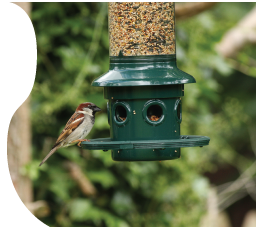
One of the best ways to enjoy wildlife in the comfort of your home is to watch birds at a feeder. You'll be amazed at the variety of birds that will come to your feeder throughout the year. Although, experts disagree about whether backyard bird feeding will significantly help bird populations, feeding certainly can help individual birds in your neighborhood. The general rule for feeding of any wild animal is: do not feed when it might cause harm. With birds there are few situations in which we can imagine harm being caused, so we say, go ahead! These answers to common questions will help you get started.
1. Where should I put bird feeders?
Birds are most likely to eat where they feel safe from predators, including free-roaming cats. Place feeders twelve feet from a brush pile, evergreen tree, or bush. Birds can quickly fly twelve feet to reach the safe cover, yet predators cannot use it to hide within striking range of the feeder. As further protection, place chicken wire or thorny branches around ground-level feeders.
2. How do I keep birds from colliding with windows?
Windows that reflect the sky and trees around them or that are very transparent can confuse birds, causing them to see a clear flight path, rather than an obstruction.
Prevent collisions by placing feeders either more than 30 feet from a window or closer than 3 feet. A feeder that is 30 feet or more from a window is a safe distance from confusing reflections, while one within 3 feet prevents a bird from building up enough momentum for a fatal collision.
Altering the appearance of your window helps, too. On the outside of the window, hang streamers, place static-cling bird strike prevention decals—especially those that reflect ultraviolet light that is visible to birds, but not to humans—about four inches apart—or paint a scene with soap. If collisions still occur, cover your windows with thin plastic garden netting, which will give a bird who still makes a wrong turn a better chance of surviving.
3. Are any human foods UNSAFE to feed birds?
Yes. Birds should not be offered many of the foods humans eat. Especially chocolate! Stick with bird food.
Create a Humane Backyard
A place that offers food, shelter, water, refuge from toxic sprays, and safety from mowers—it’s what every creature wants, right? They want a Humane Backyard. By making simple changes, you can create that haven of comfort and security for local wildlife. And you can do it anywhere: in the city, suburbs, or country. So look around--at your backyard, balcony, or the park down the street—then let us teach you how to make your own Humane Backyard. Once you’ve learned how, take our Humane Backyard pledge.
